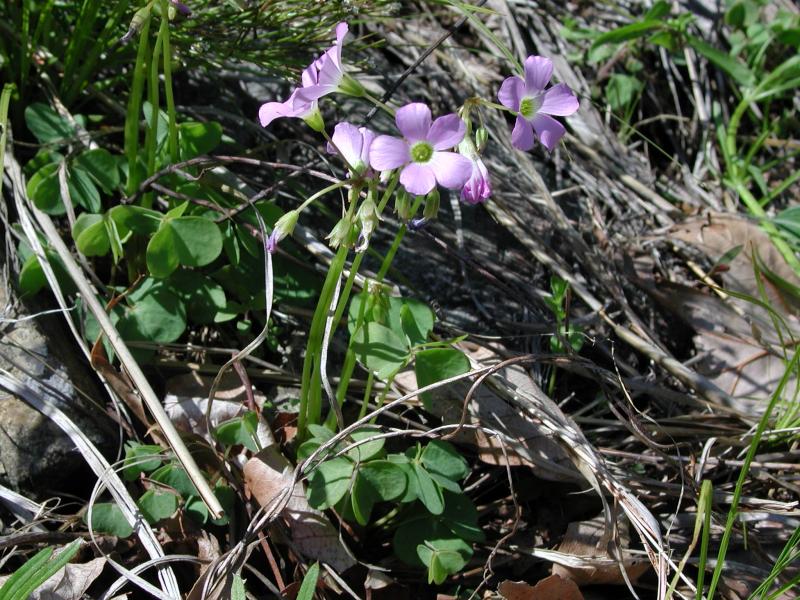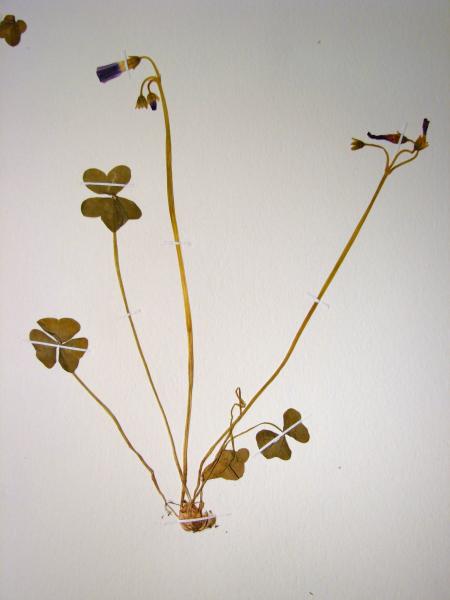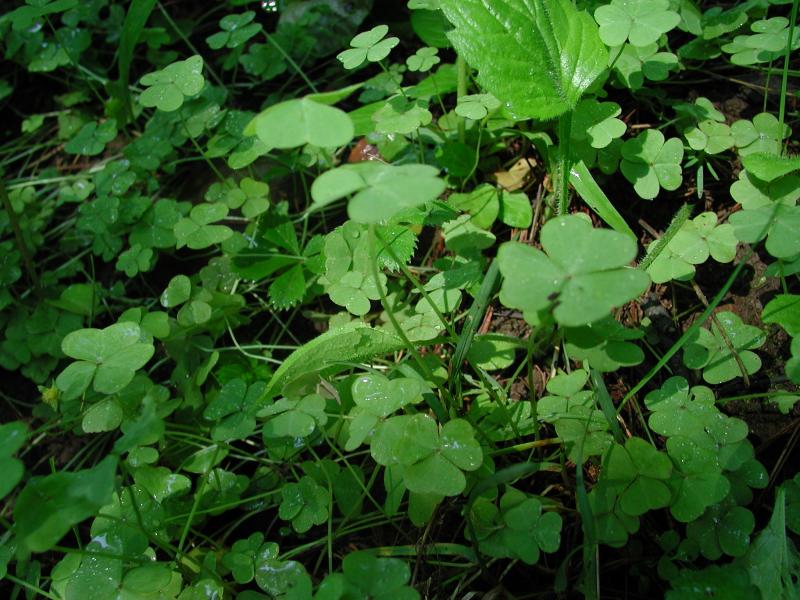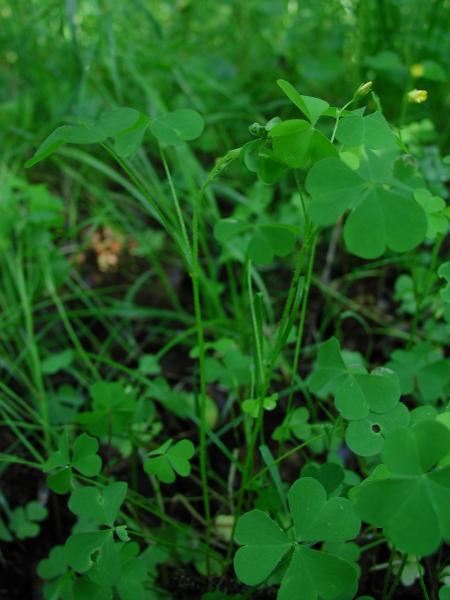Violet Wood Sorrel
Oxalis violacea L.
- Class
- Dicotyledoneae (Dicots)
- Family
- Oxalidaceae (Wood-Sorrel Family)
- State Protection
- Threatened
Listed as Threatened by New York State: likely to become Endangered in the foreseeable future. For animals, taking, importation, transportation, or possession is prohibited, except under license or permit. For plants, removal or damage without the consent of the landowner is prohibited.
- Federal Protection
- Not Listed
- State Conservation Status Rank
- S2S3
Imperiled or Vulnerable in New York - Very vulnerable, or vulnerable, to disappearing from New York, due to rarity or other factors; typically 6 to 80 populations or locations in New York, few individuals, restricted range, few remaining acres (or miles of stream), and/or recent and widespread declines. More information is needed to assign either S2 or S3.
- Global Conservation Status Rank
- G5
Secure globally - Common in the world; widespread and abundant (but may be rare in some parts of its range).
Summary
Did you know?
A characteristic of many members of this genus is that they contain oxalic acid, giving the leaves and flowers a sour taste, refreshing to chew in small amounts. However, in large amounts, these species are toxic, and interfere with proper digestion. In the past, it was a practice to extract crystals of calcium oxalate for use in treating diseases and as a salt called "sal acetosella", or "sorrel salt" (Oxalis in Wikipedia accessed 16 November 2007).
State Ranking Justification
There are 14 existing populations, and most of them contain hundreds of plants. A couple of populations contain over 1000 plants. There are 30 historical records but most of these are from areas of the Lower Hudson region and Long Island that have been developed. It is not expected that these historical occurrences would be relocated, but more populations could be found in mountainous areas that are not easily accessible.
Short-term Trends
A few of the existing populations have been resurveyed and they seem to be doing well, while more survey work is needed to have a more complete picture of short-term trends.
Long-term Trends
Most of the historical records are probably extirpated since they occurred in highly developed areas, but new discoveries have been made in more isolated natural areas where populations would tend to persist.
Conservation and Management
Threats
Understory habitat is affected by the invasion of garlic mustard, and the plants may also be trampled.
Conservation Strategies and Management Practices
Protect populations from the invasion of exotic species such as garlic mustard. Reroute trails that could threaten plants by trampling from hikers.
Research Needs
Research is needed to determine the effect of deer browse on this species since it occurs in regions of the state with high deer populations.
Habitat
Habitat
In New York Oxalis violacea has been found primarily on steep rocky slopes and open summits, generally on rocky, often rich soils. The most common surrounding forest type is oak-hickory, and at many sites the plants were found along trails, ledges, or other openings (New York Natural Heritage Program 2007). Woods, shaded slopes, gravelly banks and prairies (Fernald 1970). Dry uplands woods and prairies (Gleason and Cronquist 1991).
Associated Ecological Communities
- Appalachian oak-hickory forest
(guide)
A hardwood forest that occurs on well-drained sites, usually on ridgetops, upper slopes, or south- and west-facing slopes. The soils are usually loams or sandy loams. This is a broadly defined forest community with several regional and edaphic variants. The dominant trees include red oak, white oak, and/or black oak. Mixed with the oaks, usually at lower densities, are pignut, shagbark, and/or sweet pignut hickory.
- Calcareous talus slope woodland
(guide)
An open or closed canopy community that occurs on talus slopes composed of calcareous bedrock such as limestone or dolomite. The soils are usually moist and loamy; there may be numerous rock outcrops.
- Chestnut oak forest
(guide)
A hardwood forest that occurs on well-drained sites in glaciated portions of the Appalachians, and on the coastal plain. This forest is similar to the Allegheny oak forest; it is distinguished by fewer canopy dominants and a less diverse shrublayer and groundlayer flora. Dominant trees are typically chestnut oak and red oak.
- Red cedar rocky summit
(guide)
A community that occurs on warm, dry, rocky ridgetops and summits where the bedrock is calcareous (such as limestone or dolomite, but also marble, amphibolite, and calcsilicate rock), and the soils are more or less calcareous. The vegetation may be sparse or patchy, with numerous lichen covered rock outcrops.
Associated Species
- Acer saccharinum (silver maple)
- Alliaria petiolata (garlic mustard)
- Antennaria plantaginifolia (plantain-leaved pussy-toes)
- Anthoxanthum odoratum (sweet vernal grass)
- Aquilegia canadensis (wild columbine, red columbine)
- Arabidopsis lyrata
- Asplenium platyneuron (ebony spleenwort)
- Asplenium trichomanes
- aster ciliatus
- Cardamine parviflora (small-flowered bitter cress)
- Carex appalachica (Appalachian sedge)
- Carex blanda (eastern woodland sedge)
- Carex cristatella (crested sedge)
- Carex eburnea (bristle-leaved sedge)
- Carex laxiflora (loose-flowered sedge)
- Carex muehlenbergii
- Carex pensylvanica (Pennsylvania sedge)
- Carex platyphylla (broad-leaved sedge)
- Carya glabra (pignut hickory)
- Carya ovata
- Corydalis flavula (yellow corydalis)
- Corydalis sempervirens
- Danthonia spicata (poverty grass)
- Desmodium nuttallii (Nuttall's tick-trefoil)
- Dichanthelium acuminatum
- Dryopteris marginalis (marginal wood fern)
- Euonymus alatus (burning-bush, winged euonymus)
- Fallopia cilinodis (fringed bindweed)
- Fraxinus americana (white ash)
- Galium aparine (cleavers)
- Galium circaezans (forest wild-licorice)
- Galium mollugo
- Geranium carolinianum (Carolina crane's-bill)
- Heuchera americana
- Hieracium paniculatum (panicled hawkweed)
- Hypericum punctatum (spotted St. John's-wort)
- Juniperus virginiana
- Krigia virginica (Virginia dwarf-dandelion)
- Lespedeza violacea (wand-like bush-clover)
- Linaria vulgaris (butter-and-eggs)
- Myosotis villosa
- Orobanche uniflora (one-flowered broom-rape)
- Oryzopsis asperifolia (spreading white grass)
- Ostrya virginiana (hop hornbeam, ironwood)
- Oxalis stricta (common yellow wood sorrel)
- Parthenocissus quinquefolia (Virginia-creeper)
- Pilosella officinarum (mouse-ear hawkweed)
- Polygonatum pubescens (hairy Solomon's-seal)
- Potentilla canadensis (dwarf cinquefoil)
- Potentilla simplex (old-field cinquefoil)
- Pycnanthemum incanum
- Quercus alba (white oak)
- Quercus montana (chestnut oak)
- Quercus rubra (northern red oak)
- Ranunculus micranthus (small-flowered butter-cup, small-flowered crow-foot)
- Rumex acetosella
- Saxifraga virginiensis
- Schizachyrium scoparium
- Silene caroliniana
- Solidago caesia
- Symphyotrichum cordifolium (heart-leaved-aster)
- Symphyotrichum undulatum (wavy-leaved-aster)
- Thalictrum thalictroides (rue-anemone)
- Tiarella cordifolia (foamflower)
- Tilia americana
- Triodanis perfoliata (common Venus's looking-glass)
- Uvularia sessilifolia (wild-oats, sessile-leaved bellwort)
- Verbascum
- Veronica officinalis (common speedwell)
- Viburnum acerifolium (maple-leaved viburnum)
- Viburnum rafinesquianum
Range
New York State Distribution
Most of the known current locations for Oxalis violacea are from the Hudson Valley from Columbia County south, but it is also found on Long Island. There are historical records from Cattaraugus, Chemung, and Tioga counties in the western part of the state as well.
Global Distribution
Oxalis violacea reaches its northeast limit in Vermont and New York, and is found west in most states as far as Arizona, Colorado, Nebraska, and the Dakotas, and disjunct to Oregon.
Identification Comments
General Description
Violet Wood-sorrel is a perennial herb with a bulbous base and 3-parted (clover-like), glabrous leaves with purple undersides. There are several 5-petaled (each petal 10-18 mm long), purplish (rarely white) flowers per leafless flowering stalk.
Similar Species
Oxalis montana also has rhizomes but the base of the stem is not bulbous. It has only a single flower per stem, white flower petals with pink or purple veins, and somewhat hairy leaves with green undersides.
Both of the other species of Oxalis in New York, O. corniculata and O. stricta, are weedy species with leafy stems and yellow flowers.
Best Time to See
Oxalis violacea flowers from May to mid-June, and the fruits persist to mid-July.
- Vegetative
- Flowering
- Fruiting
The time of year you would expect to find Violet Wood Sorrel vegetative, flowering, and fruiting in New York.
Violet Wood Sorrel Images
Images of Similar Species
Taxonomy
Violet Wood Sorrel
Oxalis violacea L.
- Kingdom Plantae
- Phylum Anthophyta
- Class Dicotyledoneae
(Dicots)
- Order Geraniales
- Family Oxalidaceae (Wood-Sorrel Family)
- Order Geraniales
- Class Dicotyledoneae
(Dicots)
- Phylum Anthophyta
Additional Resources
Best Identification Reference
Gleason, Henry A. and A. Cronquist. 1991. Manual of Vascular Plants of Northeastern United States and Adjacent Canada. The New York Botanical Garden, Bronx, New York. 910 pp.
Other References
Clemants, Steven and Carol Gracie. 2006. Wildflowers in the Field and Forest. A Field Guide to the Northeastern United States. Oxford University Press, New York, NY. 445 pp.
Fernald, M.L. 1950. Gray's manual of botany. 8th edition. D. Van Nostrand, New York. 1632 pp.
Holmgren, Noel. 1998. The Illustrated Companion to Gleason and Cronquist's Manual. Illustrations of the Vascular Plants of Northeastern United States and Adjacent Canada. The New York Botanical Garden, Bronx, New York.
New York Natural Heritage Program. 2010. Biotics database. New York Natural Heritage Program. New York State Department of Environmental Conservation. Albany, NY.
New York Natural Heritage Program. 2024. New York Natural Heritage Program Databases. Albany, NY.
Newcomb, Lawrence. 1977. Newcomb's Wildflower Guide: An Ingenious New Key System for Quick, Positive Field Identification of the Wildflowers, Flowering Shrubs, and Vines of Northeastern and North-Central North America. Little, Brown and Company. Boston.
Voss, E.G. 1985. Michigan Flora. Part II. Dicots (Saururaceae - Cornaceae). Cranbrook Institute of Science and University of Michigan Herbarium. Ann Arbor, Michigan. 724 pp.
Weldy, T. and D. Werier. 2010. New York flora atlas. [S.M. Landry, K.N. Campbell, and L.D. Mabe (original application development), Florida Center for Community Design and Research http://www.fccdr.usf.edu/. University of South Florida http://www.usf.edu/]. New York Flora Association http://newyork.plantatlas.usf.edu/, Albany, New York
Weldy, Troy W. and David Werier. 2005. New York Flora Atlas. [S.M. Landry, K.N. Campbell, and L.D. Mabe (original application development), Florida Center for Community Design and Research. University of South Florida]. New York Flora Association, Albany, NY. Available on the web at (http://newyork.plantatlas.usf.edu/).
Links
About This Guide
Information for this guide was last updated on: January 18, 2008
Please cite this page as:
New York Natural Heritage Program. 2024.
Online Conservation Guide for
Oxalis violacea.
Available from: https://guides.nynhp.org/violet-wood-sorrel/.
Accessed July 27, 2024.




